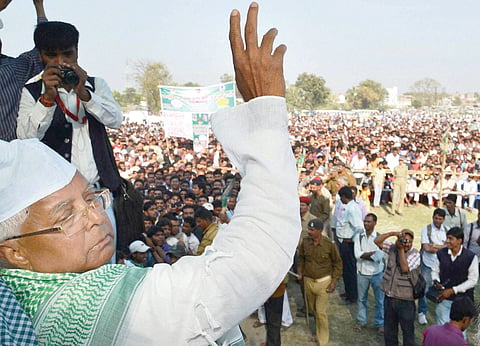

Barely a month ago, when polls began in Bihar’s southern Gangetic plain, a powerful Narendra Modi wave was reportedly sweeping the state from the west to the east. By the last week of April and first week of May when elections and campaigning moved to the northern Gangetic terai region, bordering Nepal, an equally potent cross-current from the east to the west—a late Lalu Prasad surge led by minorities—seems to have mowed down the Modi wave. The locals call the former Modi lehar (wave) and the latter Lalu samikaran (alliance advantage).
How did the Modi wave get displaced by the Lalu samikaran in north Bihar? Where did the development plank of Bihar chief minister Nitish Kumar-led Janata Dal (United) disappear? Which way will the polls head in the next two phases? What will be the final outcome?
Muslim Consolidation in Seemanchal
Much has been written about the Modi wave. In order to understand the nature of the late Lalu surge, let us focus on two regions separated by the turbulent Kosi river: Seemanchal to the east of the river and Mithilanchal to its west. Devastated by the Kosi, this is the poverty zone of Bihar thronged by minorities. Bordering West Bengal and almost touching Bangladesh, the four Seemanchal districts have the highest Muslim population in Bihar—Kishanganj (78 per cent), Katihar (43 per cent), Araria (41 per cent) and Purnia (37 per cent).
The first visible sign of minority consolidation started in Kishanganj where JD(U) candidate Aktraul Iman withdrew from the contest in favour of Mohammed Asrarul Haque, the sitting MP, fielded by the Congress, in order to prevent splitting of Muslim votes. This move, combined with Congress’s announcement of opening up of an Aligarh Muslim University centre in the region, is likely to ensure Haque’s victory against BJP candidate Dilip Kumar Jaiswal.
While this move embarrassed Nitish, especially since Iman had recently quit the RJD to join the JD(U), it has sent a strong symbolic message to the minorities across the region to consolidate their votes and arrest the Modi wave.
In 2009, the BJP in alliance with the JD(U) had swept Araria, Katihar, Purnia and Bhagalpur.
Today the strategic voting by Muslims in the region and the alliance among the RJD, the Congress and the Nationalist Congress Party (NCP) is clearly favouring NCP candidate Tariq Anwar in Katihar and RJD candidate Mohammed Taslimuddin in Araria. The RJD-Congress combine might even win some other seats in the region.
Advantage RJD in Mithilanchal
The hub of Mithilanchal, Darbhanga, was until recently associated with luscious lychees and Malda mangoes, magnificent palaces of Darbhanga Raj and the rich Mithila culture dominated by educated Brahmins. Not any more. Today the decaying city is associated with the drama of the arrest of Indian Mujahideen mastermind, the dreaded terrorist Yasin Bhatkal, and his associates.
Muslims, Brahmins and Yadavs are the three largest communities in Mithilanchal. In the past, the Congress would consecutively win with a Brahmin-Muslim-Dalit secular alliance. The social realignment of the 1990s transformed the politics of north Bihar with Lalu’s RJD forming the formidable Muslim-Yadav alliance. With the decline of the Congress, the Brahmins moved over to the BJP.
The NDA had won almost all seats of Mithilanchal in 2009. Today, the minority consolidation in Mithilanchal combined with other factors is favouring RJD in key constituencies of Darbhanga and Madhubani.
Fatimi Forges Ahead of Azad in Darbhanga
With over 23 per cent Muslim votes, Muslim candidates have won in the past from Darbhanga since 1989. RJD’s Mohammed Ali Ashraf Fatmi’s hat-trick victories in 1991, 1996 and 1998 were only stopped by the BJP’s cricketer-turned-politician Kirti Azad’s googly in 1999. Since then it has been a ding-dong battle. Azad lost to Fatimi in 2004 but won the seat defeating Fatimi again in 2009. Although a Modi wave in the rest of the country is helping BJP candidates, in Darbhanga a triangular contest between these two and another Brahmin JD(U) candidate Sanjay Jha, nicknamed “Nitish Kumar’s man Friday”, has thrown a spanner in the BJP’s wheel. Fatimi has forged ahead in this fight between two Brahmins.
Madhubani’s Marginal Seat
The big fight in the neighbouring northern constituency of Madhubani is between BJP’s 75-year-old Hukumdeo Narain Yadav, the sitting MP from Madhubani, and RJD’s Abdul Bari Siddiqui, who also hails from Darbhanga. In 2009, Hukumdeo, supported by JD(U), had narrowly defeated Siddiqui by a little over 9,000 votes. Reason: the Congress’s star candidate Shakeel Ahmed had split the Muslim vote with Siddiqui. In 2014, the Congress and RJD alliance at one point had collapsed given Congress wanting to field Ahmed again from Madhubani. But Lalu prevailed during the negotiations and Siddiqui, a more popular candidate, contested. Although the JD(U) has fielded Ghulam Ghous from Madhubani, majority of the Muslims are voting for Siddiqui.
Lalu’s Sociology Trumps Nitish’s Development Agenda
“In 2009, a BJP-JD(U) alliance swept all the seats of Mithilanchal. Today the situation is reversed. The RJD-Congress-NCP alliance has recreated the formidable M-Y coalition. In contrast, the JD(U) candidates in all seats are cutting into BJP votes post the NDA divorce,” says Shivanand Tiwari, former Rajya Sabha MP from JD(U) who quit the party.
Whether Lalu’s Muslim-led late surge prevents the Modi wave in the next two phases of polling in May in Bihar is an open issue. Nitish’s decision to divorce the BJP has proved very costly for both the allies, more for Nitish. Lalu’s political sociology has trumped Nitish’s development agenda in 2014.